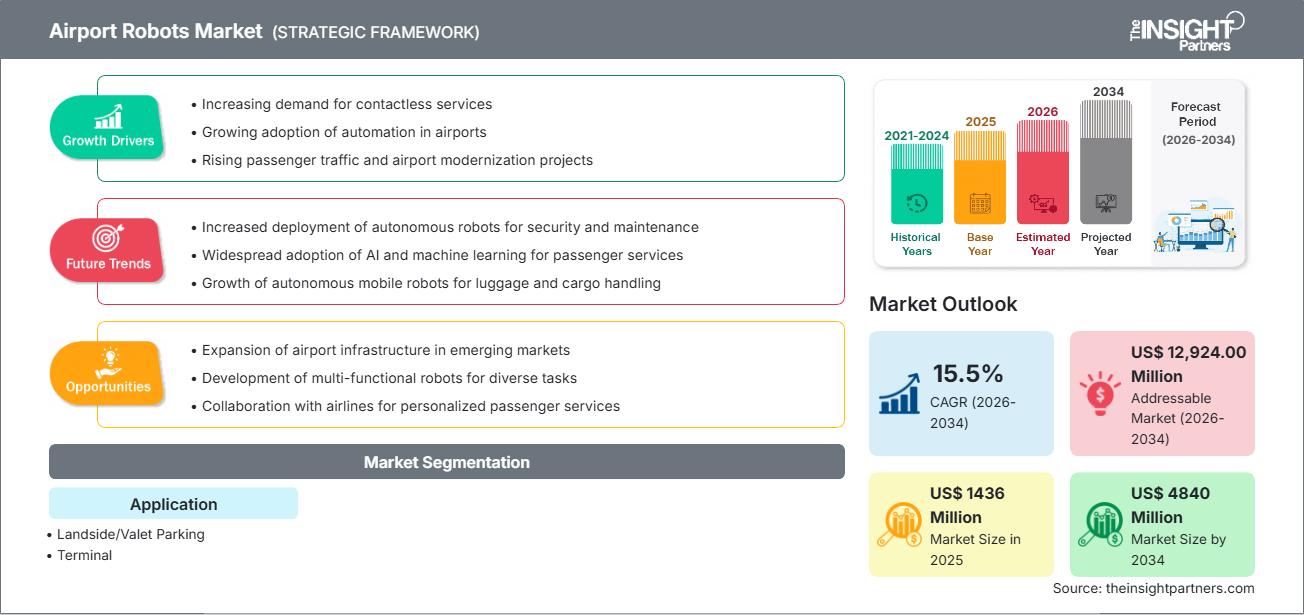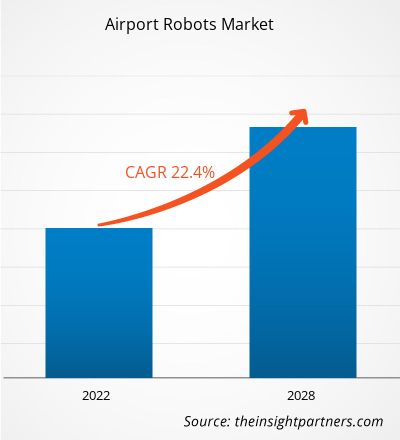预计机场机器人市场规模将从 2025 年的 14.36 亿美元增长到 2034 年的 48.4 亿美元,在预测期(2026-2034 年)内实现 15.5% 的复合年增长率。
机场机器人市场分析
机场自动化程度的提高、安保意识的增强、劳动力成本压力以及旅客对更佳体验日益增长的需求,将推动机场机器人市场快速增长。机场部署越来越多的服务机器人,用于旅客服务、清洁、行李处理甚至安检,以减少对人工的依赖,确保工作流程顺畅。人工智能、计算机视觉、人脸识别和增强型传感器的集成将进一步加速这一增长。
此外,全球范围内,尤其是在新兴市场,对机场基础设施的大力投资,以及各国政府的现代化改造计划,持续推动着需求增长。机器人不仅能提高运营效率,还有助于提升安全性和卫生水平,这在后疫情时代显得尤为重要。
机场机器人市场概览
机场机器人是部署在机场内的专用自主或半自主机器人系统,其任务范围涵盖旅客引导、安检、行李处理、清洁以及其他多种运营功能。这些机器人有助于自动化许多重复性强、资源密集型的流程,从而提高服务效率,减少人力投入和运营风险。
随着客流量的增长以及旅客对无接触、无缝机场体验的期望日益提高,这些机器人系统在机场运营现代化进程中发挥着重要作用。它们的应用涵盖了旅客体验的前端环节,例如信息亭和导览服务,以及后台运营环节,例如清洁、监控和物流。
根据您的需求定制此报告
您可以免费获得任何报告的定制服务,包括本报告的部分内容、国家/地区层面的分析、Excel 数据包,以及面向初创企业和高校的优惠折扣。
机场机器人市场:战略洞察

-
获取本报告的主要市场趋势。这份免费样品将包含数据分析,内容涵盖市场趋势、估算和预测等。
机场机器人市场驱动因素和机遇
市场驱动因素:
- 安全自动化与威胁检测:安全威胁的增加促使机场部署配备传感器、摄像头和面部识别功能的机器人,以监控人群、检测异常情况并扫描违禁品。
- 运营效率的迫切需求:机场面临着不断降低劳动力成本和优化运营的压力;机器人可以不知疲倦地执行任务,减少对清洁、行李处理和监控等人工劳动的依赖。
- 基础设施扩建与现代化:许多国家的政府都在投资建设或扩建机场,这为在机场设计早期阶段融入机器人技术提供了契机。例如,Insight Partners 的报告指出,在中国和印度等国家,新建机场是推动经济增长的重要动力。
市场机遇:
- 新兴市场的增长:新兴经济体的快速发展和机场容量的增加为机器人的部署提供了肥沃的土壤。
- 人工智能与视觉集成:利用人工智能进行导航、语音交互和人群分析,可以使机场机器人更加智能,并提高其在面向乘客方面的作用。
- 服务创新:有潜力拓展应用场景,例如多语言乘客协助、自动行李牵引、清洁和自动代客泊车机器人。
- 与机器人 OEM 厂商合作:机场可以与机器人制造商和人工智能公司合作,共同开发针对机场布局、乘客情况和监管要求量身定制的机器人解决方案。
机场机器人市场报告细分分析
以下细分遵循The Insight Partners分析中通常使用的结构:
按申请方式:
- 陆侧/代客泊车
- 终端
按地理位置:
- 北美
- 欧洲
- 亚太地区
- 南美洲和中美洲
- 中东和非洲
机场机器人市场区域洞察
The Insight Partners 的分析师对预测期内机场机器人市场的区域趋势和影响因素进行了详尽的阐述。本节还探讨了北美、欧洲、亚太、中东和非洲以及南美和中美洲等地区的机场机器人市场细分和地域分布。
机场机器人市场报告范围
| 报告属性 | 细节 |
|---|---|
| 2025年市场规模 | 14.36亿美元 |
| 到2034年市场规模 | 48.4亿美元 |
| 全球复合年增长率(2026-2034 年) | 15.5% |
| 史料 | 2021-2024 |
| 预测期 | 2026-2034 |
| 涵盖部分 |
通过申请
|
| 覆盖地区和国家 |
北美
|
| 市场领导者和主要公司简介 |
|
机场机器人市场参与者密度:了解其对业务动态的影响
机场机器人市场正快速增长,这主要得益于终端用户需求的不断增长,而终端用户需求的增长又源于消费者偏好的转变、技术的进步以及消费者对产品优势认知的提高。随着需求的增加,企业不断拓展产品和服务,持续创新以满足消费者需求,并把握新兴趋势,这些都进一步推动了市场增长。

- 获取机场机器人市场主要参与者概览
机场机器人市场份额按地域划分分析
The Insight Partners 的这份报告提供了区域细分数据,以显示不同地区的需求差异:
北美
- 市场份额和重要性:由于强大的航空基础设施、高安全标准和更高的人均技术支出,历史上一直处于采用率领先地位。
- 主要驱动因素:监管合规、劳动力成本压力以及将机器人技术整合到面向乘客和后台运营中。
欧洲
- 市场份额及重要性:凭借先进的机场和高安全及监管标准,拥有强大的市场地位。
- 关键驱动因素:注重机场运营的自动化、可持续性和效率。
亚太地区
- 增长轨迹:预计该地区将实现高速增长,这得益于机场基础设施的快速发展、强劲的客运量增长以及有利的政府政策。
- 趋势:采用人工智能机器人为乘客提供帮助、保障安全和清洁;与机器人公司加强合作。
南美洲和中美洲
- 市场潜力:航空业蓬勃发展;随着新建或升级机场,机器人技术的应用潜力巨大。
中东和非洲
- 机遇:雄心勃勃的机场扩建计划;对用于处理大量旅客和保障安全的先进机场技术的兴趣日益浓厚。
机场机器人市场参与者密度:了解其对业务动态的影响
观察到的竞争策略:
- 机场与机器人OEM厂商合作,共同打造定制机器人。
- 开发更多自主和人工智能驱动的机器人,以最大限度地提高价值,同时最大限度地减少干预。
- 强调互操作性:将机器人与机场管理系统、安全协议和乘客数据系统集成。
- 强调机器人的可靠性、电池寿命和安全认证,以满足严格的航空法规要求。
机遇与战略举措:
- 供应商可以与政府合作,参与机场现代化项目。
- 共同开发面向乘客的多语言机器人,以改善客户体验和服务差异化。
- 投资研发以降低机器人成本(硬件+软件),使即使对于较小的机场,部署机器人也能在经济上可行。
市场主要参与者:
- 裕进机器人有限公司
- Avidbots公司
- 赛博达因公司
- 软银机器人
- 斯坦利机器人SAS
- 西塔
- ABB有限公司
- ECA集团
- LG电子
研究过程中分析的其他市场参与者:
- 优傲机器人公司
- 西门子股份公司
- 泰雷兹集团
- 范德兰德工业公司
- 波士顿动力公司
- 霍尼韦尔国际公司
- 库卡股份公司
- BlueBotics SA
- UVD机器人
机场机器人市场新闻及最新进展
- Insight Partners 的报告指出,多个机场对具备面部识别和远程传感功能的安保机器人越来越感兴趣,并开始部署这些机器人。
- 斯坦利机器人公司一直在机场停车场运营自主代客泊车机器人系统,从而释放地面空间并提高效率。
- 新兴经济体(例如亚洲)的机场正越来越多地投资于旅客协助和清洁机器人,这既是容量扩张的驱动力,也是对非接触式服务的需求。
- 原始设备制造商正在开发下一代机器人系统,这些系统具有更长的电池续航时间、更好的 AI 导航和多模态交互(语音 + 触摸),以服务于不同的乘客群体。
机场机器人市场报告涵盖范围及成果
The Insight Partners发布的《机场机器人市场——预测至2034年》报告涵盖以下内容:
- 全球及区域市场规模及预测(2021-2034)
- 市场动态:驱动因素、制约因素、机遇和趋势
- 新冠疫情对机场机器人技术应用的影响评估
- 细分分析:按类型、应用、最终用户、地理位置
- PEST分析(政治、经济、社会、技术)和SWOT分析
- 竞争格局:市场集中度、主要参与者热力图、战略
- 主要参与者的详细公司简介:SITA、软银机器人、斯坦利机器人、ABB、LG电子、CYBERDYNE、裕进机器人等。
- 历史分析(2 年)、基准年、预测(7 年)及复合年增长率
- PEST和SWOT分析
- 市场规模、价值/数量 - 全球、区域、国家
- 行业和竞争格局
- Excel 数据集
近期报告
客户评价
购买理由
- 明智的决策
- 了解市场动态
- 竞争分析
- 客户洞察
- 市场预测
- 风险规避
- 战略规划
- 投资论证
- 识别新兴市场
- 优化营销策略
- 提升运营效率
- 顺应监管趋势






















 获取免费样品 - 机场机器人市场
获取免费样品 - 机场机器人市场